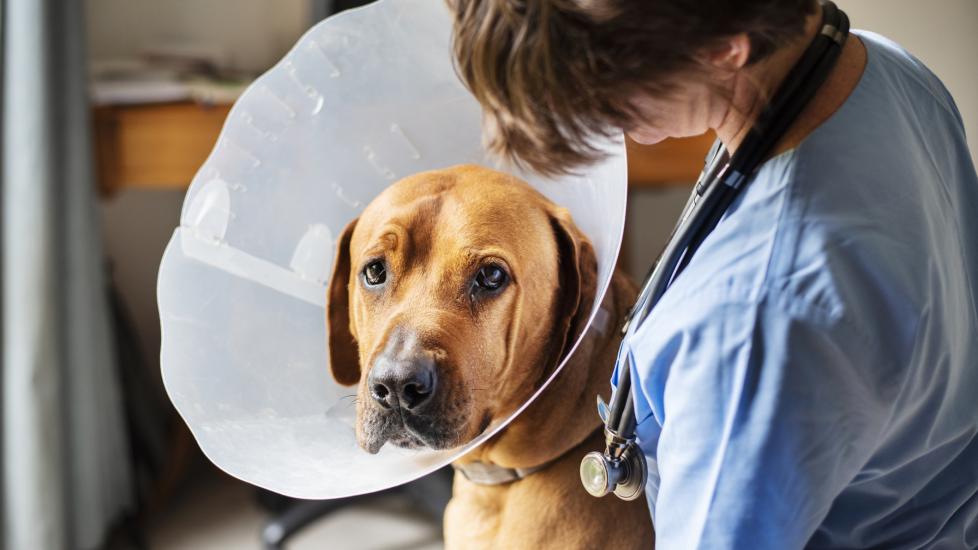Cone of Shame: What It Is and Cone Alternatives
NickyLloyd/E+ via Getty Images
What Is an Elizabethan Collar?
Many pet parents will, at some point, experience an Elizabethan collar—more commonly known as the cone of shame or e-collar. The traditional recovery cone is a plastic cone that keeps dogs and cats from licking or chewing on surgical sites, hot spots, or injuries.
Many people refer to the recovery cone as the “cone of shame” because our animal companions wear them if they try to lick and chew a wound that’s healing. When the cone is placed around their head, they may look sad, or ashamed.
Though pets don’t always enjoy wearing the recovery cone, it’s for their safety and benefit. The recovery cone is only a temporary measure, whereas not wearing the cone can lead to infection, worsening of an injury, or damage to a surgical incision.
History of the Recovery Cone
The first recovery cone was invented by a veterinarian in 1962. Dr. Frank L. Johnson got the idea from the ruffed collars worn by nobles and Queen Elizabeth I, for whom the collar was named.
The original collar was made from a thin plastic sheet. Today, most recovery cones are made from plastic or fabric to provide the same purpose.
How To Put a Cone on a Cat or Dog
Fitting a cone on a cat or dog may vary depending on the specific type of cone you choose. However, the underlying principles are the same:
-
Slip the cone over your pet's head.
-
A properly fitted recovery cone should fit snugly around the neck but still allow for two fingers to fit underneath. This is to ensure that it’s not too tight around your pet’s neck. Depending on the type of cone, your vet may give you a roll of gauze or string to tie into a bow to secure it.
-
The cone should be long enough that the pet cannot reach the affected area. For a traditional recovery cone, this usually means the cone should extend beyond your pet’s muzzle.
-
Check the fit and tightness with your veterinarian.
Alternatives to the Cone of Shame
Some pets strongly dislike wearing a recovery cone and need an alternative to protect their wounds and incisions.
Some other options for your pup may include:
-
Inflatable cones—Like fabric or plastic recovery cones, these fit around the neck of your pet, but are made to inflate. They may be more comfortable than a traditional recovery cone.
-
However, if not fitted properly, your pet may still be able to turn their body and chew or lick their wound. If using this type of cone, it’s important to ensure your pet can’t reach the affected area.
-
-
Recovery suits—Recovery suits can be a great alternative for pets who don’t like recovery cones.
-
These suits typically only work for wounds or incisions on the neck, chest, back or abdomen. If the issue is on the face, leg, or tail, the pet will still be able to reach it. These suits are typically machine washable and stylish.
-
-
Padded rings and donuts—These are large, padded, or inflatable collars in the shape of a ring or donut. These may be more comfortable for pets and allow more visibility (they improve a pets’ peripheral vision while worn).
-
It’s important to note that the rings must be large in diameter to prevent a pet from turning around to lick or chew. Even then, they may be able to access some areas such as their paws or rear end. These are not recommended for pets that are left alone or for overnight use, as they make it difficult for your companion to lie down.
-
-
Cloth cones—These cones are made of cloth and are sturdy but also collapsible. These cones are more comfortable for pets.
-
Some of these cloth cones collapse too easily, which may allow a pet to scratch, lick, or chew an incision or wound if not being supervised. Additionally, they are not typically clear like the plastic cones, which may reduce your pet's peripheral vision.
-
What Is the Best Cone for Dogs and Cats?
There’s no one-size-fits-all—choosing the best recovery cone for your pet is dependent on several factors.
This includes:
-
The location of your pet’s injury, wound, or incision—Selecting the right recovery cone or suit will be based on what where you need to prevent your pet from licking or chewing. For abdominal incisions, a recovery suit might be a good choice, but for a leg wound, the traditional plastic cone may be your best option.
-
Your pet’s disposition—Some dogs and cats highly dislike the traditional plastic cones and will fight to get them off. They may do better with a donut where they have increased visibility.
-
Durability and ease of cleaning—If your pet is going to have to wear the cone for longer than the traditional 10 to 14 days, you may want to ensure the product you select is easy to clean and durable.
-
Cost—Plastic recovery cones will typically be less expensive than a cloth cone or recovery suit. Your budget may play a factor in selecting the best option for your pet.
Speak with your veterinarian about which recovery cone or alternative is best for your pet and their specific situation.
